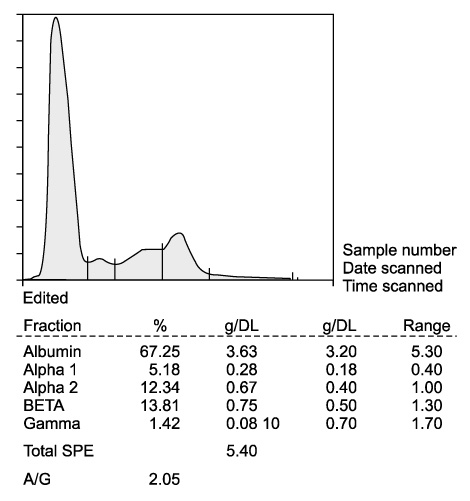Tuberc Respir Dis.
2011 Oct;71(4):282-285.
A Case of Common Variable Immune Deficiency Presenting as Recurrent Pneumococcal Pneumonia
- Affiliations
-
- 1Department of Internal Medicine, Inha University School of Medicine, Incheon, Korea. Jaehwa.Cho@inha.ac.kr
Abstract
- Common variable immune deficiency (CVID) is the most common primary immune deficiency, which is manifested as chronic recurrent respiratory infections and hypoglobulinemia. CVID usually presents in the second or third decade of life. A 33-year-old woman was admitted with recurrent pneumococcal pneumonia with bacteremia and had very low levels of serum immunoglobulin G, M and A. This case emphasized a high index of suspiciousness for diagnosis of CVID in a mid-adulthood patient presenting with recurrent pneumonia with hypoglobulinemia.
MeSH Terms
Figure
Reference
-
1. Park MA, Li JT, Hagan JB, Maddox DE, Abraham RS. Common variable immunodeficiency: a new look at an old disease. Lancet. 2008. 372:489–502.2. Cunningham-Rundles C, Bodian C. Common variable immunodeficiency: clinical and immunological features of 248 patients. Clin Immunol. 1999. 92:34–48.3. Bryant A, Calver NC, Toubi E, Webster AD, Farrant J. Classification of patients with common variable immunodeficiency by B cell secretion of IgM and IgG in response to anti-IgM and interleukin-2. Clin Immunol Immunopathol. 1990. 56:239–248.4. Primary immunodeficiency diseases. Report of a WHO scientific group. Clin Exp Immunol. 1997. 109:Suppl 1. 1–28.5. Conley ME, Notarangelo LD, Etzioni A. Diagnostic criteria for primary immunodeficiencies. Representing PAGID (Pan-American Group for Immunodeficiency) and ESID (European Society for Immunodeficiencies). Clin Immunol. 1999. 93:190–197.6. Lee MK, Bae SK, Choi SJ, Park MH, Kim YI. A case of common variable immunodeficiency. Korean J Intern Med. 1985. 28:273–280.7. Cho SJ, Kim SH, Lee SJ, Yoo KH, Kim KH. A case of common variable immunodeficiency with fatal measles. J Korean Pediatr Soc. 2001. 44:1463–1468.8. Oh TH, Lee HC, Lee TY, Song BC, Chung YH, Lee YS, et al. A case of granulomatous hepatitis associated with common variable immunodeficiency. Korean J Hepatol. 2001. 7:95–99.9. Bonilla FA, Bernstein IL, Khan DA, Ballas ZK, Chinen J, Frank MM, et al. Practice parameter for the diagnosis and management of primary immunodeficiency. Ann Allergy Asthma Immunol. 2005. 94:5 Suppl 1. S1–S3.10. Busse PJ, Razvi S, Cunningham-Rundles C. Efficacy of intravenous immunoglobulin in the prevention of pneumonia in patients with common variable immunodeficiency. J Allergy Clin Immunol. 2002. 109:1001–1004.
- Full Text Links
- Actions
-
Cited
- CITED
-
- Close
- Share
- Similar articles
-
- Agammaglobulinemia in a 8-year-old boy with recurrent pneumococcal infection and his elder brother
- Clinical Features of Primary Immunodeficiency Diseases
- A Case on Streptococcal Pneumonia Associated with Leptomeningitis, Osteomyelitis and Epidural Abscess in a Patient with AIDS
- Pneumococcal vaccine
- Disease Burden and Etiologic Distribution of Community-Acquired Pneumonia in Adults: Evolving Epidemiology in the Era of Pneumococcal Conjugate Vaccines




